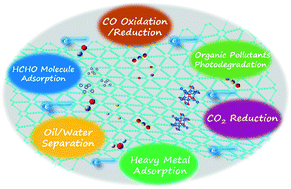Graphdiyne: an emerging two-dimensional (2D) carbon material for environmental remediation
Abstract
Global environmental problems such as pollution of air, water and soil as well as global warming have become obstacles for people to achieve high quality of life. Addressing these environmental problems is a top priority for researchers. As a new two-dimensional (2D) carbon material, graphdiyne (GDY) has been favored in environmental remediation application in recent years. GDY contains sp- and sp2-hybridized carbon atoms, which form benzene rings and diacetylenic linkages (–C![[triple bond, length as m-dash]](https://www.rsc.org/images/entities/char_e002.gif) C–C
C–C![[triple bond, length as m-dash]](https://www.rsc.org/images/entities/char_e002.gif) C–) in a two-dimensional planar network and endow it with high π-conjugation, unique and tunable electronic properties, and excellent chemical and thermal stability. Notably, the carbon–carbon triple bonds and uniformly distributed triangle pore structure of GDY provide reaction sites and multiple reaction paths due to its chemical decoration. Metal atom or heteroatom-modified GDY-based nanocomposites exhibited excellent performances in CO catalytic oxidation and reduction, adsorption of volatile organic compounds (VOCs) like HCHO, CO2 catalytic reduction and photodegradation of organic pollutants. Moreover, GDY can also serve as a filter or adsorbent by in situ growing on the surface of substrates like sponges and foams, demonstrating outstanding efficiency for removing heavy metal ions and oils from water. GDY and decorated GDY-based materials will certainly be an emerging star in the field of environmental remediation.
C–) in a two-dimensional planar network and endow it with high π-conjugation, unique and tunable electronic properties, and excellent chemical and thermal stability. Notably, the carbon–carbon triple bonds and uniformly distributed triangle pore structure of GDY provide reaction sites and multiple reaction paths due to its chemical decoration. Metal atom or heteroatom-modified GDY-based nanocomposites exhibited excellent performances in CO catalytic oxidation and reduction, adsorption of volatile organic compounds (VOCs) like HCHO, CO2 catalytic reduction and photodegradation of organic pollutants. Moreover, GDY can also serve as a filter or adsorbent by in situ growing on the surface of substrates like sponges and foams, demonstrating outstanding efficiency for removing heavy metal ions and oils from water. GDY and decorated GDY-based materials will certainly be an emerging star in the field of environmental remediation.

- This article is part of the themed collection: Best Papers 2021 - Environmental Science: Nano


 Please wait while we load your content...
Please wait while we load your content...